Introduction
Ask any experienced birder in Singapore about what’s the best and busiest month for birding and you’ll hear either October or November mentioned. After all, migratory birds are coming in fast and furious during this period. One must therefore ask the question, “Are there any studies done to establish whether these two months are indeed the best month for birding?” And if such a study exist, is it October, November or some other months? Now is as good a time as any to have find out.
Before that, let’s have two other interesting questions that are often asked. “Where are the best places for birding?”, “What’s the best time to photograph/observe birds?”. Almost everyone has thoughtful answers for them, based on their own experience and what have been passed on as common wisdom from more experienced birders. It’ll be good if we can get some hard data to confirm these as well.
Birding observation platforms like eBird or iNaturalist may provide some answers to these questions through the sheer amount of data they accumulate from birders over the years. I expect Raghav (our resident data wrangler) to provide some answers and more to these questions sooner or later, using his amazing number crunching skill.
In the meantime, playing the role of a citizen scientist, I am presenting another method here. Not as good, but simpler and tailored for photographers willing to undertake similar projects.
Most photos these days are taken with additional data (metadata) that reveals for example where and when the photo was taken. They also include what sort of camera settings that used to take these photos. When a smartphone is used to take photos, companies like Google and Apple make use of these metadata to customize and remind users of life events like past birthdays and anniversary photos for example (based on date and time encoded in photos), or maybe organize all photos taken on an overseas trip (based on location data encoded in photos) on their virtual album for the users to peruse through.
Using the same type of metadata on bird photos taken using camera gear specialized for that purpose, accumulating enough of them, and cataloging these photos and supplementing these with additional data (when necessary), one can build a mini database of information that allows more definite answers to the questions that were posed at the start of this article.
Methodology (briefly)
The base photos for this particular analysis located in a photo album posted online at https://fyap.net/photos/index/category/singapore-birds
The album contains representative photos of all the Singapore bird species I have photographed and curated over 12 years of bird photography. At the time of analysis, there are 1248 photos over 368 species. To be clear, these are non-random photo selections based on my preferences and birding habits. Photo aesthetics and other technical considerations influenced the final photo set as well.
The program/app called EXIFTool (https://exiftool.org/) is used to extract metadata of all the photos mentioned above and subsequently written to one XML file. The resulting XML file is imported into a database and through some SQL queries, tables and charts are prepared for presentation. The second step can be done in different ways. I am just outlining my general approach. Time and date-centred queries to the raw data from the photos were pared down to 11 full years starting from October 1, 2011 to September 30, 2022. The first year or so of birding wasn’t the most productive nor the most insightful, as lack of experience and a lot of trial and error on the author’s part probably distorted the data in that earlier timeframe.
Full disclosure: There are 5 photos with the wrong EXIF data information due to new camera misconfiguration. These were taken in November 2014 but the EXIF information showed October 2014. Those have been manually reassigned for the graph. The possibility always exist that human error can result in wrong interpretation of data. Luckily these errors were known ahead of time.
Results and analysis (with apologies to serious data scientist)
Best months for birding
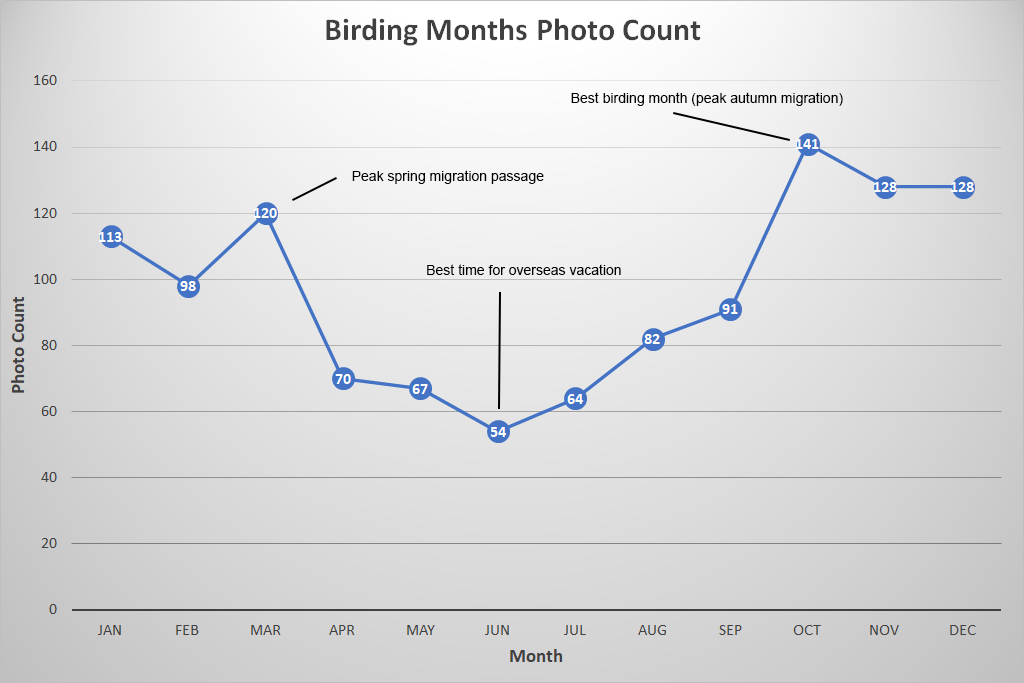
Let’s start with the assumption that bird and birding activity is correlated with the number of bird photographs posted in the album. Extracting and compiling the data on the date in which each photo was taken, we have the chart above.
Mid-year seems to have the least amount of activity locally, as migrant bird species are absent. It is a good time for birders to consider going overseas for birding. Activity start picking up during autumn migration from the north starting from July/August and reach its peak in the month of October. Hence the answer to the first question posed is October.
November and December are still active months for birding, but action tend to slow down in the new year. A modest rise in activity in March can be attributed to peak spring migration. where the migrant birds from the south return up north for their breeding season, passing briefly through Singapore.
Best time of the day for birding
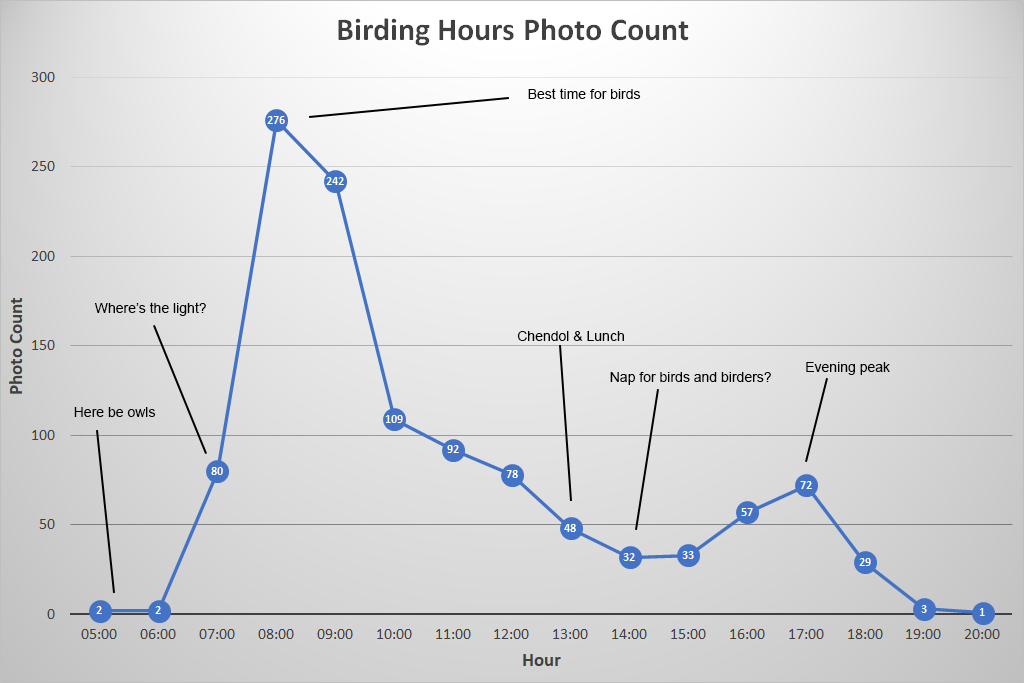
From the analysis of the time where each photo in the album was taken, we can deduce which hour is the most productive or unproductive for bird photography, and as a proxy, the best time of the day for birding.
The answer, which is from 8am up to 10am is in line with expectation or conventional wisdom. Likewise, there is a distinct lack of birding activity in the afternoon and a slight upturn in activity in the evening from 4pm to 6pm peaking at 5pm.
Due to the restriction in place for access to the nature reserves, nighttime birding is not easy nor productive, and save for some owl species, not worth the effort.
Best sites for birding
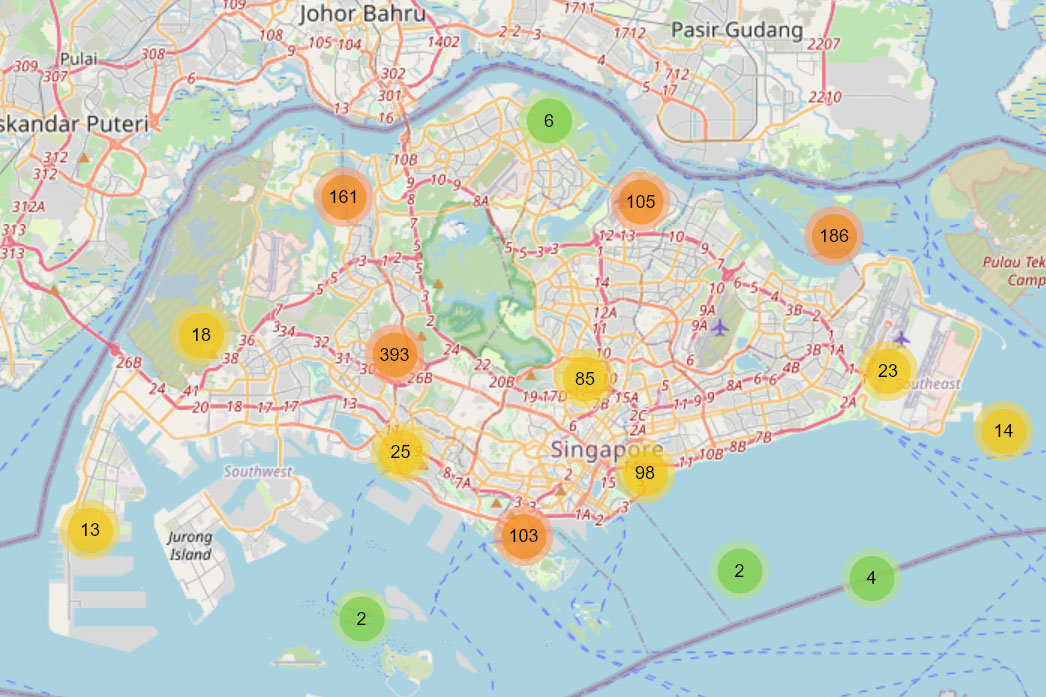
This is a screenshot of a web page generated using the same dataset used in the previous two analysis, with the help of a plugin for the photo website called Piwigo-openstreetmap. The URL https://fyap.net/photos/osmmap?/category/singapore-birds&v=1 contain the GPS location of all the bird photos in the album.
Let’s talk about the photos and their GPS coordinates. Some of these photos were encoded with built-in GPS capability in the camera (Canon EOS 7D Mk II, Canon EOS 1DX Mk II), some were from external GPS device attached to the camera (Nikon D500), some were encoded via GPS sent through the camera from the smartphone through connecting app (Sony Alpha 1, Sony Alpha 9, Canon EOS R5). Lastly, for photos taken with older camera models, i.e. photos prior to 2014, manual GPS encoding were done through memory of the places, sometimes with the help of old maps using Google Earth. This does alter the selection of photos, as I may have forgotten the precise location of some older photos and cannot put in the corresponding GPS coordinates. Hence some ‘worthy’ older photos were excluded from the photo album.
From the screenshot, the best site for birding is at the Central Catchment/Bukit Timah/Dairy Farm area. There is a particular bias in the data towards a location at Jelutong Tower, as I spent a lot of time photographing forest birds and migratory raptors at that particular location.
Pulau Ubin, Sungei Buloh/Kranji, Seletar/Punggol/Lorong Halus and Marina East/Southern Ridges areas are also noteworthy hotspots for birding.
Since the dataset is navigable through the website, it is best for those interested in specific data to explore the URL listed above for more information.
Most commonly used shutter speed
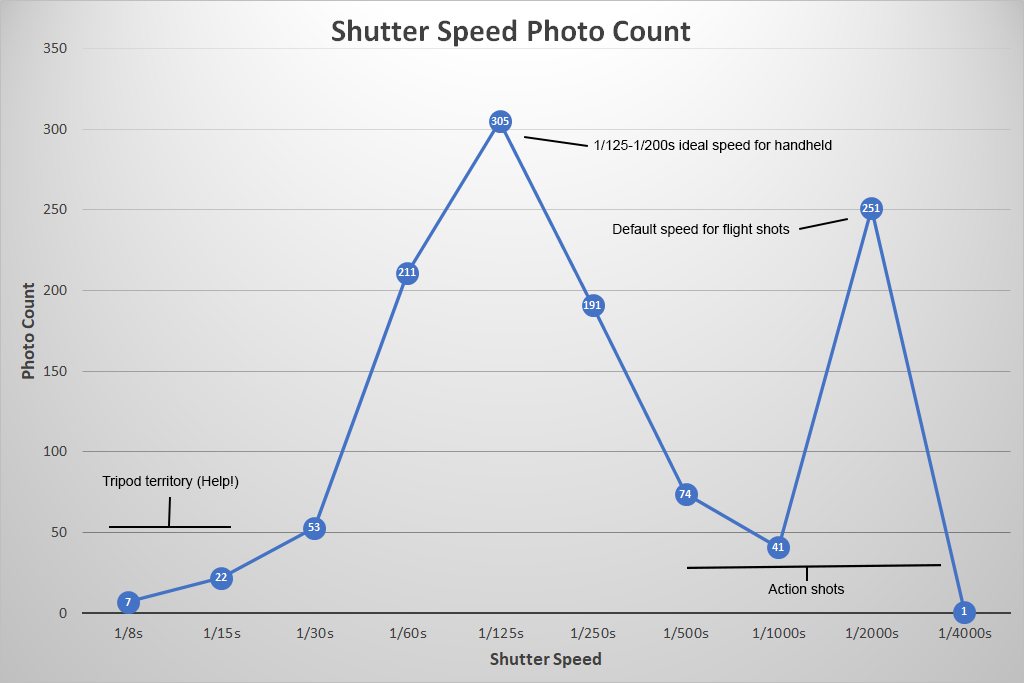
For most parts, the photoset on the website consist of photos taken handheld. Most static photos of birds are taken at the most optimal handheld shutter speed that maximises the chance of good quality photo yet remain as noise-free as possible. A shutter speed between 1/125-1/200s is my preferred option. Hence the peak at that range.
Anything below until 1/30s probably meant the birds were obliging enough, and lower lighting conditions that necessitate a lower shutter speed and consequently less odds of getting sharp photos. At 1/15s and below, shots were taken on a tripod which shutter release cable for low light conditions. Shots taken between approximately 1/250-1/1000s meant a higher probability of active birds, or action shots. The shots taken at 1/2000s and beyond are mainly flight shots.
Most commonly used ISO settings
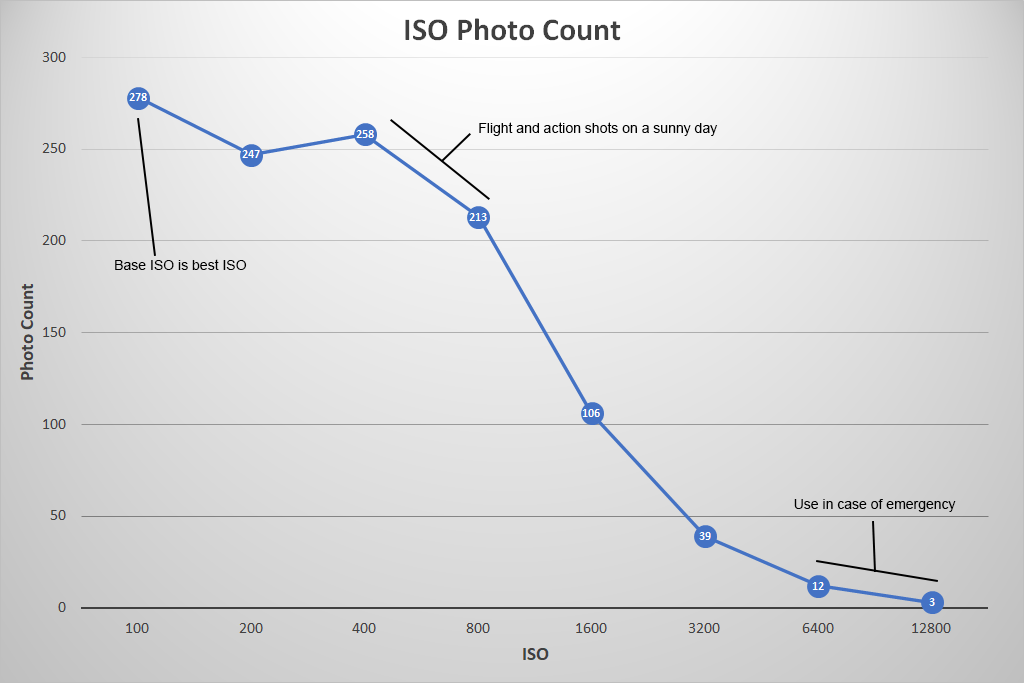
A website that tries to showcase the best representation of local birds would naturally emphasise quality photos over ones that are sub-optimal. Hence the dominance of lower ISO shots especially ISO 100 which is the base ISO for most cameras.
A slight increase at ISO 400-ISO 640 can be explained by the prominence of properly exposed flight shots on sunny days with that ISO range being used.
Although modern camera can give good photos up to ISO 6400 in some cases, bird photography is a special case. This is because while an ISO 6400 shot is acceptable if the bird subject fills the frame with no cropping, the reality is that even at 600mm full frame, most wild birds in Singapore do not fill the frame. In fact, many photos in the album are 100% crop, meaning they are cropped all the way. At such distance and at such extreme crop, high ISO photos are not the best looking. Hence the preference for lower ISO shots.
Context matters in the type of photos selected. Wild bird photos in Singapore are not taken in managed environment (like hides or feeding stations). And in many cases of uncommon or rare birds (which is a focus on the website photos), sometimes there are only a few chances given to photograph the subject. They may be very distant, taken under lower light in uncommon habitat, in the case of rare birds, with many birders squeezed in tight space with limited views, or other sub-optimal conditions.
Camera brands and models used in the photo album
| Make/Brand | Model | Photo Count |
|---|---|---|
| Canon | Canon EOS 5DS | 23 |
| Canon | Canon EOS 70D | 2 |
| Canon | Canon EOS 7D | 67 |
| Canon | Canon EOS 7D Mark II | 29 |
| Canon | Canon EOS R5 | 16 |
| Canon | Canon EOS-1D Mark IV | 124 |
| Canon | Canon EOS-1D X | 206 |
| Canon | Canon EOS-1D X Mark II | 158 |
| NIKON | NIKON D500 | 222 |
| SONY | ILCE-1 | 229 |
| SONY | ILCE-6400 | 2 |
| SONY | ILCE-9 | 170 |
One may be tempted to imagine that there are great insights to be had in looking at a table like the above. One may argue that the Canon brand is pretty dominant in bird photography due to the sheer number of models represented, or that the Sony Alpha 1 is excellent for bird photography due to the fact that on a model basis, it has the highest number of photos on the website.
Such conclusion cannot be justified by this table, because context matters. All cameras are used by only one photographer. Canon is overrepresented because in the past the author used camera for that brand exclusively for the longest time (and still does occasionally). The Sony A1 has the most entries because pre-2014 camera did not have GPS data, and some good photos cannot be posted from those models because the precise location cannot be ascertained. Camera technology have also advanced greatly, hence photos taken in recent years regardless of brands and models are overrepresented because the success rate for ‘good’ photos have greatly increased.
So what else can actually be interpreted from the above table? Well for one, there are too many cameras bought for the relatively small number of photos posted!
Conclusion
It has been fun to dig into the metadata provided by the website/photo album. Most of the results presented here are broadly in line with expectations. A larger dataset would have been helpful to get finer grained results. But we’ll leave that to another day. Hopefully what’s been presented has been insightful to others especially newer birders. Happy birding everyone!